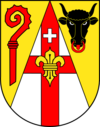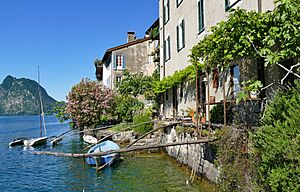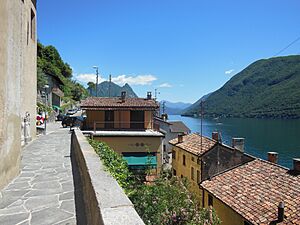Gandria facts for kids
Quick facts for kids
Gandria
|
||
|---|---|---|
|
Quarter
|
||

Gandria from Lake Lugano
|
||
|
||
 |
||
| Country | Switzerland | |
| Canton | Ticino | |
| District | Lugano | |
| City | Lugano | |
| Area | ||
| • Total | 3.45 km2 (1.33 sq mi) | |
| Population
(2012-12-31)
|
||
| • Total | 275 | |
| • Density | 79.71/km2 (206.4/sq mi) | |
Gandria is a charming village in Switzerland, located right on the beautiful Lake Lugano. It's also a part of the larger city of Lugano. Until 2004, Gandria was its own small town before it joined Lugano.
The area of Gandria includes the hills around the village. It stretches along the lake, all the way to the Italian border. It even includes some parts on the other side of the lake, like a tiny place called Cantine di Gandria. You can only reach these parts by boat or by walking.
Gandria village has a historic center that cars can't enter. People from all over the world love to visit it! While roads now reach the edge of the village, many visitors arrive by boat. You can also walk from Lugano to Gandria on a special path. This path is called the Olive path. It goes past many olive trees and offers amazing views of Lake Lugano.
Contents
Gandria's Past: A Look at History
Ancient Times: Early Settlers
The first people to live near Gandria were the Celts. They arrived around 800 B.C. You can still find a large stone called Sasso della Predescia. It has mysterious carvings and was likely used for Celtic religious events. Many places nearby still have Celtic names. For example, Gandria sits at the base of Mount Brè. "Brè" means "mountain" in Celtic.
The Italian name for Lake Lugano is Ceresio. This name might come from the Celtic word keresios. This word refers to a god of fertility. This god was always shown with deer antlers. If you look at the lake from above, it can look a bit like an antler!
Rome took control of this area in 196 B.C. We know Romans were here from tombs and items found in nearby villages. But Gandria itself was not yet a village during Roman times.
First Village: Life by the Lake
The name "Gandrio" first appears in old records from 1237. At that time, the village was located higher up on Mount Brè. You can still see the ruins of this older village today. They are along the trail to the Sasso della Predescia.
In the 1300s, a new village was built right by the lake. This is where Gandria is today. The old village higher up was eventually left empty. Maybe a fire happened, or perhaps living by the lake was just better. Gandria was only reachable by boat or by steep paths. This meant people had to be self-sufficient. They grew gardens, raised animals, and caught lots of fish from the lake.
Olives, Silk, and Smuggling Stories
Gandria was famous for its olive oil for a long time. But in 1709, a very cold winter killed most of the olive trees. In recent years, new olive trees have been planted. There are also information signs along the beautiful lakeside path to Lugano. This path is called the Sentiero dell’olivo.
In 1856, Gandria started making silk. People used leaves from local mulberry trees to feed silkworms. Because the border was hard to control, the area around Gandria became known for smuggling.
A new era for Gandria began in 1935. Tunnels and a new road were built above the lake. This connected the village to Lugano and Italy.
Joining Lugano: A New Chapter
In 2004, Gandria became part of the city of Lugano. Since then, many important projects have been completed. This includes a sewage treatment plant that opened in 2010. Work to put electrical lines underground is also happening.
Amazing Places to See in Gandria
Church of Saint Vigilio: A Historic Church
The Church of Saint Vigilio in Gandria was finished in 1463. The oldest part is the gray wall facing the lake. It has memorials from important local families. The fancy baroque parts were added in the 1870s. Behind the church's altar is a large painting. It shows the story of Saint Vigilio, who was a bishop in Trento, Italy. He was killed by pagan shepherds.
Local builders who worked on the Trento cathedral were likely impressed by Saint Vigilio. This is how the church in Gandria got its name. The artists who painted the church also painted for a local architect. He became famous for designing a royal palace in Segovia, Spain. You can even see old stones with Celtic bowl-shaped marks in the church walls and doorsteps. Villagers carried these stones here centuries ago.
Swiss Customs Museum: Smuggling Stories
Across the lake from Gandria village is the Swiss Customs Museum. This museum is still part of the Gandria area. It used to be a border post right on the Italian border. Now, it's part of the Swiss National Museum. The museum tells the history of smuggling in the area. It also shows the work of customs officers who tried to stop it. Today, it explains the work of the Swiss Federal Customs Administration and the Swiss Border Guard.
Gandria: A Village for Everyone
Today, Gandria is a mix of old traditions and modern life. Many of the 200 people who live there all year come from families who have been there for generations. Others have moved here from many different countries. These include Colombia, Germany, Haiti, Italy, Nicaragua, Palestine, and the United States. Most people work in Lugano, which is a financial center nearby. But Gandria also has a history of architects, musicians, painters, and other artists.
Getting Around Gandria
Gandria village and its surrounding areas are connected to Lugano and Italy by a main road. This road runs along the northern shore of Lake Lugano. It passes above the village center. The village center itself has very narrow and steep streets. This means cars cannot enter it. Besides the road, you can also walk from Gandria to Lugano. There is a public path along the lake called the Olive Path. It was carved into the rock in 1936.
A boat service connects Gandria to other towns on the lake. This service is provided by the Società Navigazione del Lago di Lugano (SNL) and runs regularly. The same company also has a bus service between Gandria and Lugano.
The part of Gandria on the south side of the lake, around Cantine di Gandria and the Swiss Customs Museum, has no roads. There is a path along the shore that connects to Caprino. But this path can have falling rocks and is not recommended for people who are not experienced hikers. The SNL offers several boat crossings each day from Gandria village (and central Lugano) to piers at both Cantine di Gandria and the Customs Museum.






